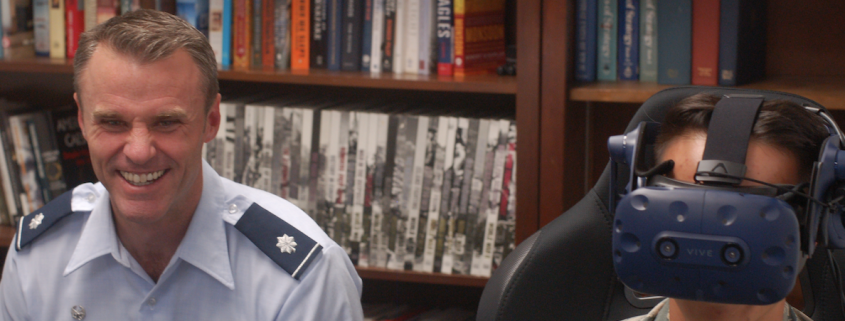AFROTC trains students with VR tools

(Ada Toydemir | Daily Trojan)
Between hours of classes and cadet training, sophomore aerospace engineering major Natalie Smith heads to the first floor of the Physical Education Building to strap on a pair of virtual reality goggles. But Smith, a cadet in the Air Force ROTC, isn’t playing a video game — she’s training to fly a plane.
Since April, USC is the first and only college to offer the optional program based off of the Pilot Next Training the Air Force uses, which uses immersive training devices to teach cadets basic piloting skills that prepare them to fly before they step foot in a plane.
Smith believes the new VR simulation program has been beneficial for student cadets who hope to fly within the Air Force. Though she was able to practice flying a real, small plane over the summer, she said the new program gives students the opportunity to practice with the simulation.
“Within the detachment, it’s very cool to have that integration with some actual flying, and it is something that I am very passionate about and the main reason why I am in this program as a whole,” Smith said. “It is also productive in the way that you’re learning, and it’s more hands-on learning than doing all the academic parts of the mechanics of flying.”
Lt. Cols. Olivia Nelson and Reid Wynans, who teach the aerospace studies courses, partnered with the VR program’s creators to pilot it at USC. The first graduates of the program completed their training at the Armed Forces Reserve Center in Austin, Texas. Wynans said using VR simulations will help cadets gain the skills and confidence they need to perform well at Air Force pilot training in the future.
Through VR simulations, cadets learn the basic controls for the T-6 Texan II, a training aircraft used in the Air Force, which gives them a better understanding of aircraft functions and system controls.
Cadets can volunteer to participate in the training and complete it on their schedules. Sean Liew, a cadet vice wing commander in the program and a senior majoring in international relations, said it helps cadets save time.
“It’s a lot of convenience in economics and saving time but also it’s in the comfort of the university where you can go to class, come here,fly for an hour, go home, go to the gym and come back right again,” Liew said. “The accessibility is a big part.”
Wynans said the program encourages students to learn flying skills early without consequences since their performance isn’t graded.
“They can begin to familiarize themselves early on and start that learning with regard to, in this case, becoming a pilot in their collegiate career, so that when they go to the Air Force’s pilot training, they already have so many of those competencies in both flying skills and the knowledge and frankly the habits of mind to be able to… have the confidence to search those ambiguous environments, make sense of those ambiguous environments, learn from it and thrive in that training environment,” Wynans said.
As the program continues, Liew said AFROTC officials will monitor how students balance the program with their course load and mandatory trainings.
“We are asking them to tackle on a lot more, and juggle the problem of having [student cadets] excel in their academics and their ROTC tasks, but also to add on this extra program and really seeing how these students can take it and how they can manage their time with how much time they’re spending in the program,” Liew said.
The future of the program is still being determined, but Wynans said he hopes the program will continue because it helps cadets learn from various instructors and peers, just like they will at Air Force training. Smith encourages students to take advantage of the training because it will help them adjust to learning skills on a real plane.
“Since a lot of the flying is muscle memory and instinct, you start to develop that earlier on, and have been exposed to all of this information before, to not only benefit yourself but help your teammates around you,” she said.

